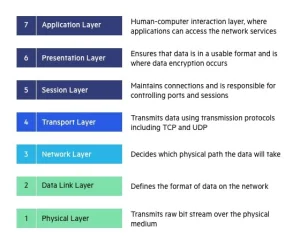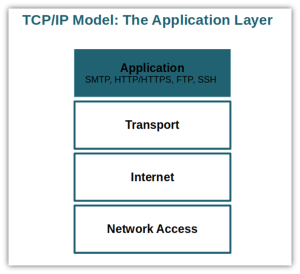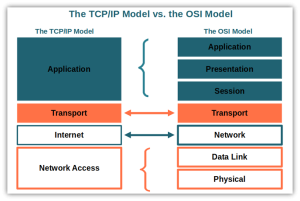OSI and TCP/IP Models
Lesson Objectives
By the end of this lesson, you will:
- Understand the purpose and structure of the OSI and TCP/IP models.
- Learn about the layers in each model and their respective functions.
- Compare the OSI and TCP/IP models to see how they complement each other.
- Explore real-world examples of protocols operating at different layers.
Introduction: Standardizing Communication
Imagine trying to communicate without a common language. Networking faced a similar challenge until standardized models were introduced. The OSI (Open Systems Interconnection) and TCP/IP (Transmission Control Protocol/Internet Protocol) models provide structured frameworks for how data flows between devices.
In this chapter, we’ll break down these models layer by layer to understand their role in seamless communication.
What is the OSI Model?
The OSI Model, developed by ISO in 1984, is a conceptual framework that standardizes communication functions into 7 layers. Each layer handles a specific task and interacts with the layers above and below it.
The 7 Layers of the OSI Model:
- Physical: Transmission of raw data bits over a medium (e.g., cables).
- Data Link: Establishes links between devices and ensures error-free data transfer.
- Network: Handles routing and addressing (e.g., IP addresses).
- Transport: Ensures reliable data delivery through segmentation and reassembly.
- Session: Manages sessions between devices (e.g., start, maintain, terminate).
- Presentation: Formats data for the application layer (e.g., encryption, compression).
- Application: Provides network services to end-user applications (e.g., HTTP, FTP).

Visualizing the OSI Model:
| Layer | Function | Example Protocols |
|---|---|---|
| Application | End-user services | HTTP, FTP, SMTP |
| Presentation | Data translation, encryption | SSL/TLS, JPEG |
| Session | Session management | NetBIOS, RPC |
| Transport | Reliable delivery, flow control | TCP, UDP |
| Network | Routing, addressing | IP, ICMP |
| Data Link | Frame formatting, MAC addressing | Ethernet, PPP |
| Physical | Bit transmission | Ethernet cables, Wi-Fi |
What is the TCP/IP Model?
The TCP/IP Model, introduced by the U.S. Department of Defense, is a simpler, more practical framework than the OSI model. It focuses on protocols and real-world implementation across 4 layers.
The 4 Layers of the TCP/IP Model:
- Application: Combines OSI’s Application, Presentation, and Session layers. Handles high-level protocols for user interaction (e.g., HTTP).
- Transport: Ensures reliable communication between hosts (e.g., TCP, UDP).
- Internet: Manages addressing and routing of packets across networks (e.g., IP).
- Network Access: Combines OSI’s Physical and Data Link layers, handling hardware-level transmission (e.g., Ethernet).

Visualizing the TCP/IP Model:
| Layer | Function | Example Protocols |
|---|---|---|
| Application | End-user services | HTTP, FTP, DNS |
| Transport | Reliable delivery | TCP, UDP |
| Internet | Routing, addressing | IP, ICMP, ARP |
| Network Access | Physical data transfer | Ethernet, Wi-Fi |
Comparison of OSI and TCP/IP Models
| Aspect | OSI Model | TCP/IP Model |
|---|---|---|
| Layers | 7 Layers | 4 Layers |
| Concept | Theoretical, for standardization | Practical, for implementation |
| Flexibility | Separate Presentation and Session layers | Combined Application layer |
| Examples | Covers a broad range of protocols | Focuses on Internet protocols |
Encapsulation and Decapsulation
Encapsulation:
- The process of adding headers (and sometimes trailers) to data as it moves down the layers.
- Example: Sending an email.
- Application layer formats the email using SMTP.
- Transport layer breaks it into segments and adds TCP headers.
- Internet layer adds IP addresses.
- Network Access layer sends frames over the medium.
Decapsulation:
- The process of removing headers as data moves up the layers on the receiving end.
Real-World Example: Sending a Web Request
- Application Layer (HTTP):
- User requests a webpage. HTTP formats the request.
- Transport Layer (TCP):
- Data is segmented and ensured for delivery.
- Internet Layer (IP):
- The IP address of the server is added.
- Network Access Layer (Ethernet):
- Data is converted to bits and sent through cables or Wi-Fi.
On the receiving end, these steps are reversed to deliver the requested webpage.
Key Takeaways
- OSI Model: Best for understanding theoretical concepts and standardization.
- TCP/IP Model: Practical framework used for real-world networking.
- Both models emphasize modular communication, ensuring interoperability across different systems and vendors.
Activity: Match Layers to Protocols
- Identify which OSI and TCP/IP layers the following protocols belong to:
- FTP
- ICMP
- Ethernet
- TCP
Reflection: Why Learn These Models?
Understanding these models helps you diagnose network issues, configure devices, and design scalable networks. They provide a universal language for networking professionals to communicate effectively.
What’s Next?
In the next chapter, we’ll dive into Encapsulation and Decapsulation Processes, understanding how data flows through these layers in greater detail.
Your networking knowledge is deepening—let’s keep building! 🚀

